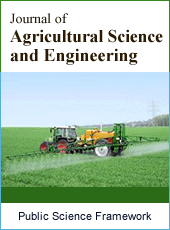Journal of Agricultural Science and Engineering
Articles Information
Journal of Agricultural Science and Engineering, Vol.1, No.3, Aug. 2015, Pub. Date: Jul. 20, 2015
Evaluation of Plant Growth Promoting Rhizobacteriaas Biocontrol Agents for the Control of Blast Disease in Rice
Pages: 135-142 Views: 5319 Downloads: 4669
[01]
Mansoureh-Sadat Sharifi-Noori , Department of Agronomy, Payame Noor University, Tehran, Iran.
[02]
Halimi Mohd Saud, Department of Agro-Technology, University Putra Malaysia, Selangor, Malaysia.
[03]
Elham Azizi, Department of Agronomy, Payame Noor University, Tehran, Iran.
The antagonistic effects of three Pseudomonas isolates from rhizosphere of rice were evaluated against Pyricularia.oryzae in vitro and in vivo. Fungal inhibition tests were performed using plate assay. Each isolate was tested for the production of protease, siderophore, cyanide hydrogen, indole acetic acid and phosphate solubilization activity. All the 20 tested isolates of Pseudomonads fluorescent were positive for the production of siderophores and HCN, while 15 strains (75%) were positive for the production of plant growth-promoting hormone, IAA. Among the 20 isolates, 19 isolates showed phosphate solubilisation on NBRIP medium. Biocontrol activity and plant growth promotion of bacterial strains were evaluated under greenhouse conditions, in which soil-inoculation of NCIM 2099 (the reference strain), TS3C8 and TS3B5 reduced disease index to a range of 13.50% (P ≤ 0.05) compared to the untreated control at 28.8%. Greenhouse experiments revealed that the plants treated with TS3C8 isolate recorded maximum root length, plant height, and fresh shoot weight which were increased by 32.78 cm, 76.16 cm, and 5.84 g, respectively over the diseased control. These results indicate that the tested PGPR improved growth parameters in rice plants and contribute towards biocontrol of the blast pathogen.
Antagonism, Biological Control, PGPR, Pseudomonas Spp, Rice Blast Disease
[01]
Ahmad F, Ahmad I, Khan MS (2005): Indole acetic acid production by the indigenous isolates of Azotobacterandfluorescent Pseudomonas in the presence and absence of tryptophan. Turk. J. Biol 29, 29-34.
[02]
Atzel B, Szoboszlay S, Mikuska Z, Kriszt B (2008): Comparison of phenotypic and genotypic methods for the detection of environmental isolates of Pseudomonas aeruginosa. International journal of hygiene and environmental health 211, 143-155.
[03]
Defago G, Berling CH, Burger U, Haas D, Kahr G, Keel C, Voisard C, Wirthner P, and Wüthrich B, Hornby D (1990): Suppression of black root rot of tobacco and other root diseases by strains of Pseudomonas fluorescens: potential applications and mechanisms. CAB International, pp. 93-108.
[04]
Ghazanfar MU, Wakil W, Sahi ST (2009): Influence of various fungicides on the management of rice blast disease. Mycopath 7, 29-34.
[05]
Gnanamanickam SS, Mew TW (1992): Biological control of blast disease of rice (Oryzasativa L.) with antagonistic bacteria and its mediation by a Pseudomonas antibiotic. Annals of the Phytopathological Society of Japan 58.
[06]
Irri RF (1993): International Rice Research Institute. Manila, Philippines
[07]
Karimi, K., Amini, J., Harighi, B., and Bahramnejad, B. (2012). Evaluation of biocontrol potential of ‘pseudomonas' and ‘bacillus' spp. against fusarium wilt of chickpea. Australian Journal of Crop Science, 6(4), 695.
[08]
Khan, A. G. (2006). Mycorrhizoremediation— an enhanced form of phytoremediation. Journal of Zhejiang University-Science B, 7(7), 503-514.
[09]
Kloeppe JW, Rodriguez-Kabana R, Zehnder AW, Murphy JF, Sikora E, Fernandez C (1999): Plant root-bacterial interactions in biological control of soilborne diseases and potential extension to systemic and foliar diseases. Australasian Plant Pathology 28, 21-26.
[10]
Kuyek, D., Quijano, D. R., and Zamora, D. O. B. (August 2000). Blast, biotech and big business. Implications of corporate strategies on rice research in Asia. 2011, from http://www.grain.org/article/entries/36-blast-biotech-and-big-business-implications-of-corporate-strategies-on-rice-research-in-asia.
[11]
Naik P, Raman G, and Narayanan K, Sakthivel N (2008): Assessment of genetic and functional diversity of phosphate solubilizing fluorescent pseudomonads isolated from rhizospheric soil. BMC microbiology 8, 230.
[12]
Nakata Y, Ueno M, Kihara J, Ichii M, Taketa S, Arase S (2008): Rice blast disease and susceptibility to pests in a silicon uptake-deficient mutant lsi1 of rice. Crop Protection 27, 865-868.
[13]
Naureen Z, Price AH, Hafeez FY, Roberts MR (2009): Identification of rice blast disease-suppressing bacterial strains from the rhizosphere of rice grown in Pakistan. Crop Protection 28, 1052-1060.
[14]
Rabindran, R., and Vidhyasekaran, P. (1996). Development of a formulation of Pseudomonas fluorescens PfALR2 for management of rice sheath blight. Crop Protection, 15(8), 715-721.
[15]
Sambrook, J., and Russell, D. W. (2001). Molecular cloning: a laboratory manual (Vol. 2): CSHL press.
[16]
Sariah M (1994): Potential of Bacillus spp. as a biocontrol agent for anthracnose fruit rot of chilli. Mal. Appl. Biol 23, 53-60.
[17]
Shivakumar B 2007: Biocontrol potential and plant growth promotional activity of fluorescent pseudomonads of western ghats, Dharwad, India, 88p. (M.Sc. Dissertation. Department of agricultural microbiology college of agriculture, university of agricultural sciences).
[18]
Suresh A, Pallavi P, Srinivas P, Kumar VP, Chandra SJ, Reddy SR (2010): Plant growth promoting activities of fluorescent pseudomonads associated with some crop plants. African Journal of Microbiology Research 4, 1491-1494

ISSN Print: 2381-6821
ISSN Online: 2381-6848
Current Issue:
Vol. 7, Issue 4, December Submit a Manuscript Join Editorial Board Join Reviewer Team
ISSN Online: 2381-6848
Current Issue:
Vol. 7, Issue 4, December Submit a Manuscript Join Editorial Board Join Reviewer Team
| About This Journal |
| All Issues |
| Open Access |
| Indexing |
| Payment Information |
| Author Guidelines |
| Review Process |
| Publication Ethics |
| Editorial Board |
| Peer Reviewers |


